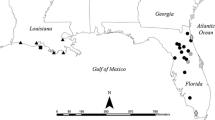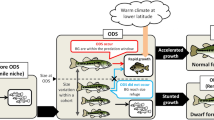Abstract
Ontogenetic allometries in ecological habits and niche use are key responses by which individuals maximize lifetime fitness. Moreover, such allometries have significant implications for how individuals influence population and community dynamics. Here, we examined how body size variation in Komodo dragons (Varanus komodoensis) influenced ecological allometries in their: (1) prey size preference, (2) daily movement rates, (3) home range area, and (4) subsequent niche use across ontogeny. With increased body mass, Komodo dragons increased prey size with a dramatic switch from small (≤10 kg) to large prey (≥50 kg) in lizards heavier than 20 kg. Rates of foraging movement were described by a non-linear concave down response with lizard increasing hourly movement rates up until ∼20 kg body mass before decreasing daily movement suggesting reduced foraging effort in larger lizards. In contrast, home range area exhibited a sigmoid response with increased body mass. Intrapopulation ecological niche use and overlap were also strongly structured by body size. Thus, ontogenetic allometries suggest Komodo dragon’s transition from a highly active foraging mode exploiting small prey through to a less active sit and wait feeding strategy focused on killing large ungulates. Further, our results suggest that as body size increases across ontogeny, the Komodo dragon exhibited marked ontogenetic niche shifts that enabled it to function as an entire vertebrate predator guild by exploiting prey across multiple trophic levels.




Similar content being viewed by others
References
Ariefiandy A, Purwandana D, Coulson G, Forsyth DM, Jessop TS (2013) Monitoring the ungulate prey of the Komodo dragon Varanus komodoensis: distance sampling or faecal counts? Wildl Biol 19:126–137
Auffenberg W (1981) Behavioral ecology of the Komodo monitor. University Presses of Florida, Gainesville
Bolnick D, Ingram T (2010) Ecological release from interspecific competition leads to decoupled changes in population and individual niche width. Proc R Soc B 227:1789–1797
Bolnick DI, Svanbäck R, Fordyce JA et al (2003) The ecology of individuals: incidence and implications of individual specialization. Am Nat 161:1–28
Brown JS (1988) Patch use as an indicator of habitat preference, predation risk, and competition. Behav Ecol Sociobiol 22:37–47
Bull JJ, Jessop TS, Whitely M (2010) Deathly drool: evolutionary and ecological basis of septic bacteria in Komodo dragon mouths. PLoS ONE 5:e11097
Carbone C, Mace GM, Roberts SC, Macdonald DW (1999) Energetic constraints on the diet of terrestrial carnivores. Nature 402:286–288
Carbone C, Cowlishaw G, Isaac NJ, Rowcliffe JM (2005) How far do animals go? Determinants of day range in mammals. Am Nat 165(2):290–297
Carbone C, Teacher A, Rowcliffe JM (2007) The costs of carnivory. PLoS Biol 5(2):e22. doi:10.1371/journal.pbio.0050022
Ciofi C, Puswati J, Winana D et al (2007) Preliminary analysis of home range structure in the Komodo monitor, Varanus komodoensis. Copeia 2007:462–470
R Core Team (2013) R: A language and environment for statistical computing. R Foundation for Statistical Computing, Vienna, Austria. URL http://www.R-project.org/
Damuth J (1981) Population density and body size in mammals. Nature 290(5808):699–700
Emlen JM (1966) The role of time and energy in food preferences. Am Nat 100:611–617
Fitzgerald M, Shine R, Lemckert F (2002) Spatial ecology of arboreal snakes (Hoplocephalus stephensii Elapidae) in an Eastern Australian forest. Aust Ecol 27:527–545
Frankham R (1998) Inbreeding and extinction: island populations. Conserv Biol 12:665–675
Garland T Jr (1983) Scaling the ecological cost of transport to body mass in terrestrial mammals. Am Nat 121:571–587
Giraldeau LA, Caraco T (2000) Social foraging theory. Princeton University Press, Princeton
Gompper ME, Gittleman JL (1991) Home range scaling: intraspecific and comparative trends. Oecologia 87:343–348
Green B, King D, Braysher M et al (1991) Thermoregulation, water turnover and energetics of free-living komodo dragons Varanus komodoensis. Comp Biochem Physiol A 99:97–101
Guarino F (2002) Spatial ecology of a large carnivorous lizard, Varanus varius (Squamata: Varaniae). J Zool (Lond) 258:449–457
Harris S, Cresswell WJ, Forde PG et al (1990) Home-range analysis using radio-tracking data: a review of problems and techniques particularly as applied to the study of mammals. Mammal Rev 20:97–123
Heithaus M, Dill L, Marshall G et al (2002) Habitat use and foraging behavior of tiger sharks (Galeocerdo cuvier) in a seagrass ecosystem. Mar Biol 140:237–248
Hooge PN, Eichenlaub W, Solomon E (1999) The Animal Movement Program. USGS, Alaska Biological Science Center. (Online) http://www.absc.usgs.gov/glba/gistools/index.html
Huey RB, Pianka ER (1981) Ecological consequences of foraging mode. Ecology 62:991–999
Humphries NE, Weimerskirch H, Sims DW (2013) A new approach for objective identification of turns and steps in organism movement data relevant to random walk modelling. Methods Ecol Evol 4:930–938. doi:10.1111/2041-210X.12096
Imansyah MJ, Jessop TS, Ciofi C, Akbar Z (2008) Ontogenetic differences in the spatial ecology of immature Komodo dragons. J Zool 274(2):107–115
Jessop TS et al (2004) Distribution, use and selection of nest type by Komodo Dragons. Biol Conserv 117:463–470
Jessop TS, Madsen T, Sumner J et al (2006) Maximum body size among insular Komodo dragon populations covaries with large prey density. Oikos 112:422–429
Jessop TS, Madsen T, Ciofi C et al (2007) Island differences in population size structure and catch per unit effort and their conservation implications for Komodo dragons. Biol Conserv 135:247–255
Jetz W, Carbone C, Fulford J et al (2004) The scaling of animal space use. Science 306(5694):266–268
Jones M (1997) Character displacement in Australian dasyurid carnivores: size relationships and prey size patterns. Ecology 78:2569--2587
Kenward RE (1996) Ranges V: an analysis system for biological location data. Institute of Terrestrial Ecology, Wareham
Lande R (1993) Risks of population extinction from demographic and environmental stochasticity and random catastrophes. Am Nat 142:911–927
Laundré JW (2010) Behavioral response races, predator-prey shell games, ecology of fear, and patch use of pumas and their ungulate prey. Ecology 91(10):2995–3007
Laundré JW, Reynolds TD, Knick ST et al (1987) Accuracy of daily point relocations in assessing areal movement of radio-marked animals. J Wildl Manag 51:937–940
Laver RJ, Purwandana D, Ariefiandy A et al (2012) Life-history and spatial determinants of somatic growth dynamics in Komodo dragon populations. PLoS One 7(9):e45398
MacArthur RH, Pianka ER (1966) On optimal use of a patchy environment. Am Nat 100:603–609
Mace GM, Harvey PH (1983) Energetic constraints on home-range size. Am Nat 121:120–132
McCauley E, Wilson W, de Roos A (1996) Dynamics of age-structured predator-prey populations in space: asymmetrical effects of mobility in juvenile and adult predators. Oikos 76:485–497
McCurry MR, Mahony M, Clausen PD, Quayle MR, Walmsley CW, Jessop TS et al (2015) The relationship between cranial structure, biomechanical performance and ecological diversity in varanoid lizards. PLoS ONE 10(6):e0130625. doi:10.1371/journal.pone.0130625
McNab BK (1963) Bioenergetics and the determination of home range size. Am Nat 97:133–140
Monk KA et al (1997) The ecology of Nusa Tenggara and Maluku. Oxford Univ. Press, Oxford
Nifong JC, Layman CA, Silliman BR (2015) Size, sex and individual‐level behaviour drive intrapopulation variation in cross‐ecosystem foraging of a top‐predator. J Anim Ecol 84(1):35–48
Oksanen J, Blanchet FG, Kindt R et al (2011) Vegan: community ecology package. R Package Version 1:17–10
Perry G, Garland T Jr (2002) Lizard home ranges revisited: effects of sex, body size, diet, habitat and phylogeny. Ecology 83:1870–1885
Pianka ER, Vitt LJ (2003) Lizards: windows to the evolution of diversity. University of California Press, Berkeley
Polis GA (1984) Age structure component of niche width and intraspecific resource partitioning—can age-groups function as ecological species. Am Nat 123:541–564
Pough FH (1980) The advantages of ectothermy for tetrapods. Am Nat 115:92–112
Purwandana D, Ariefiandy A, Imansyah MJ et al (2014) Demographic status of Komodo dragons populations in Komodo National Park. Biol Conserv 171:29–35
Purwandana D, Ariefiandy A, Imansyah MJ et al (2015) Evaluating environmental, demographic and genetic effects on population-level survival in an island endemic. Ecography. doi:10.1111/ecog.01300
Radloff FGT, Du Toit JT (2004) Large predators and their prey in a southern African savanna: a predator’s size determines its prey size range. J Anim Ecol 73:410–423. doi:10.1111/j.0021-8790.2004.00817.x
Ray JC, Sunquist ME (2001) Trophic relations in a community of African rainforest carnivores. Oecologia 127:395–408
Samuel MD, Fuller MR (1996) Wildlife radio-telemetry. In: Bookhout TA (ed) Research and management techniques for wildlife and habitats: 370–418. The Wildlife Society, Bethesda
Schmidt-Nielsen K (1984) Scaling: why is animal size so important? Cambridge Univ. Press, Cambridge
Schoener TW (1968) Sizes of feeding territories among birds. Ecology 49(1):123–141
Schoener TW (1969) Models of optimal size for solitary predators. Am Nat 122:240–285
Schoener TW (1971) Theory of feeding strategies. Annu Rev Ecol Syst 2:369–404
Shine R (1986) Sexual differences in morphology and niche utilization in an aquatic snake, Acrochordus arafurae. Oecologia 69:260–267
Sih A (1998) Game theory and predator–prey response races. In: Dugatkin JA, Reeves HK (eds) Game theory and animal behavior. Oxford University Press, New York, pp 221–238
Sims DW, Southall EJ, Humphries N, Hays GC, Bradshaw CJA, Pitchford JW et al (2008) Scaling laws of marine predator search behaviour. Nature 451:1098–1102
Swanson HK, Lysy M, Power M et al (2015) A new probabilistic method for quantifying n-dimensional ecological niches and niche overlap. Ecology 96:318–324
Taylor JA (1979) The foods and feeding habits of subadult Crocodylus porosus Schneider in northern Australia. Wildl Res 6:347--59
Thompson G, De Boer M, Pianka ER (1999) Activity areas and daily movements of an arboreal monitor lizard, Varanus tristis (Squamata: Varanidae) during the breeding season. Aust J Ecol 24:117–122
Tucker AD, Limpus CJ, McCallum HI, McDonald KR (1996) Ontogenetic dietary partitioning by Crocodylus johnstoni during the dry season. Copeia 1996:978–988
Viswanathan GM, da Luz MGE, Raposo EP, Stanley H (2011) The physics of foraging. Cambridge University Press, New York
Werner EE, Gilliam JF (1984) The ontogenetic niche and species interactions in size-structured populations. Annu Rev Ecol Syst 15:393–425
Werner EE, Hall DJ (1988) Ontogenetic habitat shifts in bluegill: the foraging rate-predation risk trade-off. Ecology 69:1352–1366
White GC, Garrott RA (1990) Analysis of wildlife radio-tracking data. Academic, San Diego
Wood SN (2006) Generalized additive models: an introduction with R. Chapman and Hall/CRC Press, Boca Raton
Wood S (2010) Package mgcv. R Package Version 1:8–9
Acknowledgments
We thank all the Komodo National Park staff and volunteers who assisted us in field work. Financial support from the Zoological Society of San Diego; the Komodo Species Survival Plan of the American Zoo and Aquarium Association, the Ocean Park Conservation Foundation, Hong Kong, the Mohamed bin Zayed species conservation fund and the Taronga Conservation Society, Australia is gratefully acknowledged. This research was conducted via a Memorandum of Understanding (MOU) between Komodo Survival Program and the Indonesian Department of Forestry and Conservation (PHKA).
Author information
Authors and Affiliations
Corresponding author
Additional information
Communicated by: Sven Thatje
Rights and permissions
About this article
Cite this article
Purwandana, D., Ariefiandy, A., Imansyah, M.J. et al. Ecological allometries and niche use dynamics across Komodo dragon ontogeny. Sci Nat 103, 27 (2016). https://doi.org/10.1007/s00114-016-1351-6
Received:
Revised:
Accepted:
Published:
DOI: https://doi.org/10.1007/s00114-016-1351-6




